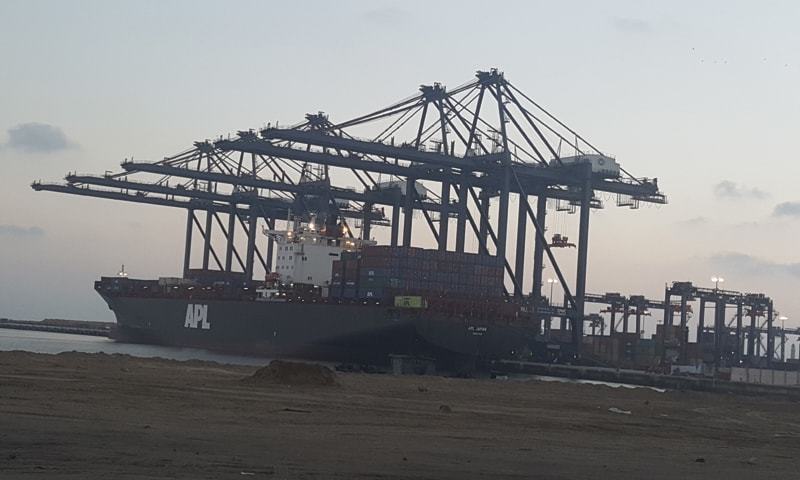ghazi52
PDF THINK TANK: ANALYST

- Joined
- Mar 21, 2007
- Messages
- 103,081
- Reaction score
- 106
- Country
- Location
Country’s biggest port starts test operations

KARACHI: The port can handle 3.1 million twenty-foot equivalent units a year (TEUs).
KARACHI: Pakistan Deep Water Container Port (PDWCP), the country’s biggest port, started test operations on Friday by accommodating the first container ship, APL Japan.
Official sources said the vessel took along side berth No. 4 of the port at 3pm for loading around 1,000 twenty-foot equivalent units (TEUs) of export cargo.
However, the vessel having a draft of 12 metres and an overall length of 262 metres is a small vessel for a big port like the PDWCP, which has a designed draft of 18 metres and operational draft of 16 metres.
The port, located at Keamari groyne east of Karachi Port, has the capacity to handle mother ships.
The APL Japan first called at Karachi International Container Terminal, West Wharf Karachi Port, and unloaded containers of import cargo and later shifted to the PDWCP, sources said.
Sources said that keeping in view safety factors in mind, a small vessel has been deliberately selected for test operations. They hoped that the PDWCP would be inaugurated by Prime Minister Nawaz Sharif in the third week of January.
Moreover, using a smaller vessel also provided an opportunity to the terminal operator to experience and check possible flaws.
The vessel came from Jebel Ali, a deep port located in Dubai, and will leave on Saturday (today) at 2pm for China via Colombo Port, Sri Lanka. This indicated that the port may play a major role in the China-Pakistan Economic Corridor (CPEC), the sources added.
Under the first phase of development, the terminal operator, South Asia Pakistan Terminals (SAPT), has constructed berths No.3 and 4 while berths No. 1 and 2 would be taken up for completion under the second phase.
A spokesman for SAPT, owned and operated by Hutchison Ports of Hong Kong, said it has invested around $600 million. The terminal operator has already brought in equipment, including five ship-to-shore gantry cranes.
Besides, the terminal operator has also completed three building blocks to be used for administration, customs and canteen. A power station with a generation capacity of 28 megawatts is also ready.
The port has the capacity to handle 3.1m TEUs a year and have a storage yard to accommodate 550,000 TEUs a year, sources said.

KARACHI: The port can handle 3.1 million twenty-foot equivalent units a year (TEUs).
KARACHI: Pakistan Deep Water Container Port (PDWCP), the country’s biggest port, started test operations on Friday by accommodating the first container ship, APL Japan.
Official sources said the vessel took along side berth No. 4 of the port at 3pm for loading around 1,000 twenty-foot equivalent units (TEUs) of export cargo.
However, the vessel having a draft of 12 metres and an overall length of 262 metres is a small vessel for a big port like the PDWCP, which has a designed draft of 18 metres and operational draft of 16 metres.
The port, located at Keamari groyne east of Karachi Port, has the capacity to handle mother ships.
The APL Japan first called at Karachi International Container Terminal, West Wharf Karachi Port, and unloaded containers of import cargo and later shifted to the PDWCP, sources said.
Sources said that keeping in view safety factors in mind, a small vessel has been deliberately selected for test operations. They hoped that the PDWCP would be inaugurated by Prime Minister Nawaz Sharif in the third week of January.
Moreover, using a smaller vessel also provided an opportunity to the terminal operator to experience and check possible flaws.
The vessel came from Jebel Ali, a deep port located in Dubai, and will leave on Saturday (today) at 2pm for China via Colombo Port, Sri Lanka. This indicated that the port may play a major role in the China-Pakistan Economic Corridor (CPEC), the sources added.
Under the first phase of development, the terminal operator, South Asia Pakistan Terminals (SAPT), has constructed berths No.3 and 4 while berths No. 1 and 2 would be taken up for completion under the second phase.
A spokesman for SAPT, owned and operated by Hutchison Ports of Hong Kong, said it has invested around $600 million. The terminal operator has already brought in equipment, including five ship-to-shore gantry cranes.
Besides, the terminal operator has also completed three building blocks to be used for administration, customs and canteen. A power station with a generation capacity of 28 megawatts is also ready.
The port has the capacity to handle 3.1m TEUs a year and have a storage yard to accommodate 550,000 TEUs a year, sources said.




















